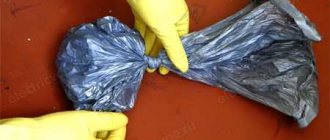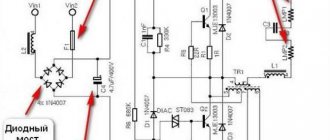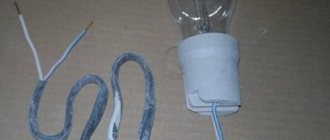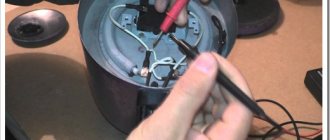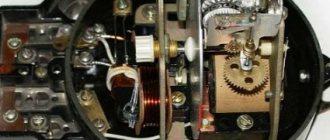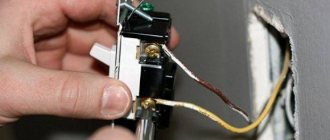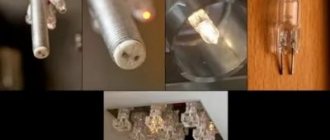Procedure
- Immediately turn off the climate control devices (air conditioner, fan, etc.).
- Remove all family members and domestic animals, if any, from the premises.
- Organize high-quality ventilation of the room. In this case, it is necessary to exclude drafts, for which all doors to adjacent rooms are tightly closed, and the windows are fully opened. It is impossible to clearly indicate the exact time of such natural ventilation, since everything depends on local conditions - the dimensions of window openings, the “square” of the room, the wind rose and a number of others. You should focus on the minimum period, which experts determine to be 2 hours. Although to fully guarantee high-quality ventilation, at least 12 may be needed.
- Recycle broken energy-saving light bulbs. All work is carried out only in protective equipment, primarily for the hands. If you don’t have rubber gloves at home, you can replace them with regular plastic bags. It is recommended to collect the fragments with a damp cloth; their storage is organized in any suitable container with an airtight lid. As a rule, this is a glass jar that is pre-filled with water.
- Thoroughly wash the floor in the area where the lamp broke. Any chlorine-containing product or soap-soda solution will do.
Recommendations for demercurization
This is the name of the measures, the purpose of which is to neutralize the effects of mercury vapor and its chemical compounds. In this case – wet cleaning.
Recipes for the preparation of drugs (in g/l).
- Iodine (100 ml). For small areas.
- Potassium permanganate (2). It processes the entire segment where fragments of an energy-saving lamp have scattered. Waiting for at least 6 hours, after which the floors are washed again with soapy water.
- Baking soda (40). Instead, you can use detergent (optionally, “Whiteness”).
If the lamp breaks on the carpet, then it needs to be taken outside, thoroughly knocked out and left there for a while for proper ventilation.
What is prohibited:
- Use a vacuum cleaner to collect light bulb fragments.
- Pour the contents of the container (can) into the sewer system.
- Reuse the rags used to collect the fragments. They are also recyclable.
After wet cleaning, it is advisable to immediately take a shower to wash off all the “dirt.”
But what to do with the assembled parts of an energy-saving light bulb needs to be clarified with the Ministry of Emergency Situations. The attendant will advise you on how to properly dispose of the remains of hazardous products. Each locality has its own way of organizing this process. In some, there are containers everywhere that are designed specifically for collecting such waste, in others there are special collection points.
Is it possible to throw away energy-saving lamps?
According to statistics, up to 70 million ESLs stop operating every year. Half of them are thrown into household waste bins, and the other half are handed over to specialized recycling points. Improperly disposed waste ends up in landfills, where it releases toxic substances into the air that enter the body.
The threat of mercury vapor is that it has a cumulative effect in the body. When a dangerous level of content in the body is reached, a person receives a toxic effect on the nervous system, liver, lungs and other organs.
The problem in some settlements is that they do not have special containers or nearby collection points. For such cases, it is necessary to call on volunteers who will periodically accept lamps.
There are almost 50 enterprises that recycle such lamps. Initially, parts and elements are separated from them, and then processing begins. The result is glass, mercury, aluminum. Such processing is not only economically beneficial, but also prevents environmental pollution.
We recommend watching the video:
https://youtube.com/watch?v=HS6LCAJ3qhU
How much mercury is in lamps?
A traditional thermometer can be used as a reference example. Its flask contains no more than 2.6 g of mercury; the content of mercury vapor in a single-lamp fluorescent lamp does not exceed 1–5 mg (i.e., several thousandths of a gram). Such an amount cannot cause serious intoxication of the body, however, there are extremely unpleasant consequences.
Mercury content in the lamp
Attention! Back in 2004, applied research was carried out on breaking down fluorescent lamps. “Full-scale tests” were carried out inside a closed container in which an energy-saving lamp broke. The experiment gave the following results:
- Immediately after breaking the flask, more than 50% of the total amount of mercury vapor it contained is released.
- Mercury in amounts up to 40% is gradually released from the fragments in the form of vapor. (The remaining amount remains on the bound inner lining of the broken flask).
- In the first 24 hours, approximately half (i.e., up to 20% of the total amount) of the toxic metal is released from the fragments. As a result, after 24 hours, at least 70% of 2.5 mg of mercury (the most common content) will accumulate in the atmosphere of the apartment, if ventilation is not done.
This will lead to the fact that the maximum permissible concentration of highly reactive and hygroscopic mercury vapor, which will be contained in the atmosphere of the house, will exceed the norm by 5 - 10 times (depending on the area of the space). But the concentration will be within the so-called. "industrial" MPC.
So, summary:
- It is impossible to quickly become poisoned by such an amount of mercury - its content is too insignificant.
- The real danger is the careless behavior of a person when the lamp is broken, and he continues to be in the room, and does not take measures to localize the fragments, as well as through ventilation. However, such harm to health is cumulative in nature, and its consequences manifest themselves over a long period of time.
What to do if a fluorescent lamp breaks?
There are two ways to solve the problem with a broken energy-saving fluorescent light bulb. The first is officially stipulated by regulatory documents, provides for a number of measures to eliminate mercury compounds and is approved by the Russian Ministry of Emergency Situations. The second is simpler and consists of a minimum set of actions necessary to clean the room from mercury contamination. Let's consider both options in detail.
Disposal according to rules
The entire procedure for cleaning a room from a broken energy-saving lamp can be performed by one person in several stages:
Isolate the room from people and animals. Open the window wide, ensuring the maximum possible outflow of polluted air from the room naturally
Some of the mercury vapor will evaporate. Proceed with careful collection of fragments using personal protective equipment. After cleaning, thoroughly wipe the surface with a damp cloth, and then place all the fragments along with the used material in a bag and tie it tightly. Over the next few days, ventilate the room where the incident occurred. For further disposal, hazardous waste should be handed over to one of the LL collection points
This could be a district housing office, a private company that processes mercury-containing products, or an IKEA brand store, whose departments accept non-working light bulbs of any manufacturer.
For further disposal, hazardous waste should be handed over to one of the LL collection points. This could be a district housing office, a private company for processing mercury-containing products, or an IKEA brand store, whose departments accept non-working light bulbs of any manufacturer.
Quick solution to the problem
The first step is to repeat the first two points of the previous section. Then place the large pieces of the broken light bulb in a trash bag. Wide tape, available in almost any home, is ideal for collecting small fragments and particles of mercury. The tape is cut into strips 10–20 cm long, pressed onto areas of possible contamination and then carefully placed in a garbage bag.
After removing visible residues, the smooth surface is thoroughly washed with a solution of “Whiteness” or any other bleach containing chlorine. If the incident happened on the carpet, then the task becomes slightly more complicated. The carpet will need to be taken out into the fresh air, dried and, if possible, left to air out for a couple of days.
Some online resources insist on demercurization of the premises, that is, the removal of mercury compounds by physical and chemical means with the involvement of employees of the Ministry of Emergency Situations. In the case of one broken energy-saving lamp, this event will be unnecessary. Another thing is a broken thermometer, the mercury content in which is 1000 times higher. In such a situation, calling a specialist is necessary even after collecting the toxic substance yourself. In addition to demercurization of the premises, the specialist will measure harmful vapors using highly sensitive devices AGP-0.1ST and RGA-11.
What not to do
There is a list of actions that do not need to be performed if an energy-saving light bulb cracks or breaks:
- Many people are mistaken that turning on the air conditioner will help quickly release mercury vapor from the room. On the contrary, these vapors will settle on the filter inside the air conditioner, and, in the future, will be released in parts, poisoning the air in the room.
- ESL fragmentation parts are assembled only by hand. The use of a vacuum cleaner is prohibited. The fragments also contain a poisonous coating, the vapors of which will settle on the vacuum cleaner filter.
- Brooms and brushes are also not suitable for collecting lamp fragments. Particles can get stuck between the bristles and end up in another room.
- The fragmented parts are not washed away in sewer systems. They can get stuck in water pipes.
- Leftover ESL should not be thrown into trash bins. They do not belong to household waste. In addition, they can cause great damage to the environment.
Is there mercury in energy-saving lamps?
The popularity of energy-saving light bulbs is due to the fact that they consume little electricity, emit a powerful luminous flux, and last a long time. However, these devices also have their disadvantages.
Energy-saving lamps contain mercury, which is a highly toxic chemical. Inside the glass flask is filled with this metal in a gaseous state. After turning on the lamp, the passing electricity heats up the substance, which begins to glow.
After the lamp breaks, the mercury begins to evaporate and produce toxic fumes that can cause intoxication in the body. This substance disrupts the functioning of many internal organs. Vapors enter the body through the upper airways. At the same time, a person does not even smell it.
In addition, energy-saving devices contain argon without color, taste and odor; the inner surface of the flask is coated with a light-accumulating pigment (luminophor).
Attention! After damage to an energy-saving lamp, about 40% of mercury vapor evaporates from pieces of glass and fluorescent coating. The remaining substance settles on the inner surface of the flask.
However, not all energy-saving devices contain mercury; some light sources are coated with calcium amalgam (an alloy of calcium and mercury). The inside surface of the light bulb is coated with an alloy; in this form, mercury is safe, since it is chemically bound.
This is interesting! A certain amount of mercury is contained in fluorescent, sodium, metal halide lamps, etc. When creating diode light sources, substances containing mercury are not used, in addition, they do not emit ultraviolet radiation.
An energy-saving light bulb breaks: is it dangerous?
In addition to obvious advantages, energy-saving light bulbs also have disadvantages. They contain mercury in a gaseous state. It is thanks to her that the room is illuminated.
It is a liquid, fusible, volatile metal of a silvery-white color. When the lamp is intact, mercury is safe for humans. But if integrity is violated, then you need to be very careful.
If a light bulb breaks, then in addition to the sharp glass, mercury instantly spreads throughout the apartment - about 3-7 mg. It leads to poisoning, deterioration of health, and sometimes to more serious consequences.
The toxic effect of mercury increases many times at elevated temperatures (from + 16 ° C).
Energy saving lamp broke
Energy-saving lamps can be found in every apartment today. Many, in pursuit of savings, completely abandon simple incandescent lamps and install only energy-saving ones. However, not everyone knows what is inside these lamps and why they are dangerous. And inside them there is mercury, and in a gaseous state. When sealed, the lamp is safe for health and use. But as soon as you accidentally break it, all the mercury will end up in the air, inside your apartment.
What to do if an energy-saving lamp breaks
Energy-saving lamps are deservedly popular because they are more economical and durable. But few people know that energy-saving lamps contain mercury, and this in some cases makes them hazardous to health. Mercury in lamps is in a gaseous state and it is this that causes the glow during an electrical discharge.
During normal use of the lamp, toxic compounds are not released, but as soon as its integrity is damaged (during transportation or careless installation), toxic mercury immediately enters the air
Due to the widespread use of mercury-containing fluorescent lamps, it is important to know what actions should be taken if an energy-saving lamp breaks, where you can dispose of used and damaged lamps
If an energy-saving lamp breaks in a room, a person is exposed to a number of dangerous factors. The first danger is glass shards, which can easily cut you. The second and more serious danger is mercury, which is classified as a chemical compound of the first hazard class.
If the lamp breaks, mercury vapor freely enters the air and spreads easily in it. One energy-saving lamp contains 3-5 mg of this extremely toxic substance, such an amount is enough to cause deterioration in health. In case of mild poisoning, a person feels weakness, headache and dizziness. In case of longer contact with mercury vapor, the person’s condition becomes critical, severe damage to all internal organs and the central nervous system occurs, which can lead to death.
Effect of mercury vapor on humans
It is gaseous mercury that poses a danger to humans , which is extremely toxic . With prolonged contact with it, internal organs are damaged and can cause cancer . Acute mercury poisoning can be fatal .
In acute forms of intoxication, the following symptoms of malaise are possible:
- Weakness in the body.
- Strong headache.
- Lack of appetite, attacks of nausea.
- Painful sensations when eating and drinking.
- Unpleasant metallic taste in the mouth.
- Increased salivation.
- Periodic abdominal cramps.
- A severe cough may occur.
- Difficulty breathing, shortness of breath.
- A sharp increase in body temperature, chills.
These symptoms appear within 8 hours of exposure to mercury vapor. They are typical for both adults and children, but in children these processes occur rapidly.
The process of recycling energy-saving lamps
In order not to harm the environment, an energy-saving lamp cannot be used
leave in regular containers and bury in the ground. Everything that came into contact with the aggressive substance is taken to special tanks for devices containing mercury. Next, the lamps are sent to production for further processing.
The obtained substances are reused in production. This method allows you to save on materials and prevent environmental pollution. Activities can only be carried out by enterprises that have received a license from government agencies.
Many people have a question about how to properly dispose of
energy-saving lamps? Where should we take them? Unfortunately, there is practically no information support for this issue.
Anyone can freely hand over broken devices. In our country, everything is a little more complicated, but there is a way out. According to government order 949-RP, any citizen can hand over unnecessary equipment to a collection point free of charge.
Disposal nuances
With the beginning of mass production of energy-saving fluorescent lamps, the problem of their disposal is acute throughout the world. Russia is following a well-trodden path in this matter: it bans the production of high-power incandescent lamps and gives the “green light” to the so-called housekeepers, which, with the help of advertising campaigns, quickly gained popularity and won the trust of the population.
But the authorities tried not to directly declare the danger. Why? Because recycling worn-out mercury-containing lamps is a very expensive process for any country. Even in economically developed Western Europe, organizational arrangements for receiving burnt-out fluorescent lamps remained at a low level. People continue to massively throw them away with regular waste, without thinking about the consequences.
In Russia and the CIS countries, information about the dangers and methods of proper disposal is much worse. Many people only know that the glass bulb of an energy-saving lamp cannot be broken. Few people have any idea about the amount of harmful substances under glass and their effect on the body. Someone with a broken “housekeeper” treats it like an ordinary light bulb, while others simply deliberately throw it into a container with household waste.
It is surprising that even many people who know about the presence of toxic vapors inside the light bulb are negligent in disposing of the damaged bulb in their home. The reasoning in such cases is simple: industrial enterprises, exhaust gases and poor-quality water cause much more harm to the body every day. Therefore, a broken mercury lamp is not so dangerous and has much less weight among other harmful factors.
What to do if an energy-saving light bulb at home breaks
If you suddenly break an ESL, then you should not panic, but you should immediately call specialists. However, proper disposal depends on the circumstances under which it crashed. In general, you need to adhere to the following set of rules:
- first of all, you need to remove children and animals from the room - the door must be closed immediately so that mercury vapor does not spread throughout the house;
- perform all actions carefully, as there is a risk of cutting yourself with a splinter;
- if the ESL was screwed into the lamp, then it must be immediately disconnected from the power supply;
- open the window in the room where the emergency occurred;
- close the windows and doors in all other rooms - this will help avoid drafts and, accordingly, the spread of mercury vapor;
- the room where the light bulb was broken should be ventilated for about a day - no one should enter it;
- pour water into a jar and add potassium permanganate there, put on rubber or other gloves: you cannot collect fragments with your bare hands;
- you need to place all the fragments in a jar with a solution of water and potassium permanganate;
- Collect very small glass particles with a wet cloth or adhesive tape;
- after all the fragments have been collected, close the jar and call the Ministry of Emergency Situations - they will tell you where you can take the waste for further processing;
- after that, wash the floor with detergent;
- take a shower;
- the shoes and clothes you were wearing when you collected the glass need to be washed.
If you followed these rules, then there is no danger. It is also worth remembering that if there was a carpet in the room, then it needs to be put away where there are no people, and then thoroughly shaken and knocked out. After this, it should be left to ventilate outside for 24 hours.
Why can't you throw it away with regular trash?
It is worth remembering that under no circumstances should a broken energy-saving light bulb be collected with regular garbage, since the mercury vapor will simply settle in the trash can and you will still breathe it. We talked about the possible consequences earlier.
To ensure your health is not at risk, you need to consider the following:
- Do not pick up debris with a vacuum cleaner. The mercury will end up inside and settle on the walls of the bag. Moreover, its vapors can escape while the vacuum cleaner is running and spread throughout the house.
- The air conditioner cannot be turned on. If it was turned on and the light bulb broke, turn it off immediately.
- It is prohibited to use a broom. Excessively intense movements cause mercury particles to fly throughout the room.
- Do not dispose of broken pieces or a can of broken pieces in a regular garbage disposal. The jar may break and the harmful substance will begin to spread throughout the house.
- It is prohibited to pour the contents into the sewer.
How to properly dispose of
Also, you should not throw away used light bulbs with regular trash. They must be handed over to specialized collection points. Information about them can be found in stores that specialize in selling energy-saving light bulbs. Some of them have specialized reception points.
If there are no such points, then you can get all the necessary information from the employees of the Ministry of Emergency Situations.
An energy-saving lamp breaks: what to do?
What is the difference between mercury in fluorescent lamps and mercury in thermometers? What is the danger of a broken energy-saving light bulb and what to do with it? And what can replace compact fluorescent lamps?
Those energy-saving lamps that we widely use in everyday life are compact fluorescent lamps (also known as CFLs). They differ in shape, base volume and power, but all contain mercury. In the article about thermometers, we already talked about how it is dangerous for humans: its toxic vapors enter the lungs and lead to the elimination of the body. Symptoms include headache, nausea, dry and metallic taste in the mouth, abdominal pain, and diarrhea. But you need to understand that the mercury in a thermometer and a light bulb are different. If it pours out in shiny balls from a broken thermometer, then you won’t find them among the fragments of a light bulb, because it contains mercury in the form of vapor, which is very small, about 5 mg (for comparison, in a thermometer it is 2-3 grams). Therefore, according to experts, there is little harm from a broken light bulb.
Photo: Bruce Guenter
In addition, not everything is the same energy-saving lamp as the one with mercury. Ecological consultant Vadim Rukavitsyn points out that such lamps come in different types, and some of them do not contain mercury in principle, such as LED lamps: “In fact, only fluorescent lamps can pose a danger - here the risk lies in mercury vapor , which are contained in the flask, albeit in small quantities. If one small light bulb breaks, there will most likely be no problem, but there are a number of measures that need to be taken to ensure you are 100% safe.”
The media are escalating the situation around the dangers of energy-saving lamps. For example, NTV journalists scare viewers with the fact that a broken lamp threatens severe poisoning “up to damage to the liver, kidneys and nervous system of a person,” as well as the threat of Minamata disease, “characterized by impaired motor skills, weakness in the arms and legs, weakened vision, hearing, and in severe cases - paralysis and even death.”
Not really. A broken light bulb does not threaten anything like that. To dispel existing myths, Greenpeace Russia even published a special booklet. In it, environmentalists gave a special place to the procedure for cleaning up a broken lamp. “If a lamp breaks, it is enough to carefully collect the fragments and thoroughly ventilate the room,” Greenpeace recommends.
Photo: Anton Fomkin
For anxious citizens who find this algorithm of action insufficiently convincing, we can advise performing manipulations similar to cleaning up a broken thermometer, but note that the psychological benefit from this is much greater than the practical one. In any case, do the following:
- open the windows and ventilate the room;
- close all doors to adjacent rooms, remove pets and children;
- put on rubber gloves, shoe covers and a gauze bandage;
- pick up lamp fragments using adhesive tape, a damp sponge or rag;
- Place the materials used during cleaning and things that have received fragments in a plastic bag and hand them over to a specialized facility for recycling.
If a broken lamp is not dangerous, why is there a separate container for disposal of burnt-out lamps rather than a common one?
Indeed, light bulbs should not be thrown away with household waste. But this does not mean at all that if they are broken, they are deadly to humans. The reason is different: you also cannot throw, say, batteries, accumulators, or some types of chemical cleaners into a common container. That is, the requirements for special disposal of lamps are related to the need for separate waste collection, proper recycling and, finally, environmental conservation.
Photo: Wilson Hui
What can replace CFL?
Technologies do not stand still, and now, in addition to energy-saving LED lamps, you can buy energy-saving lamps that do not contain hazardous metals at all. “Not all energy-saving lamps contain mercury vapor in their design,” explains Ilya Katorgin, an environmental specialist at the EcoStandard group, “some manufacturers make lamps a little differently. Instead of mercury, a metal alloy, calcium amalgam, is introduced into the flask itself. The alloy is distinguished by the fact that in it the mercury is in a bound state. The advantage of using this substance is that at room temperature it is not able to evaporate, therefore eliminating the possibility of it getting into the air we breathe.”
The fact that the light bulb is made using a special technology can be recognized by the mark on the packaging “Does not contain mercury” or “Amalgam technology”.
What is the danger of a broken energy-saving lamp?
The danger is posed by mercury vapor contained inside such a lamp. You should know that if a light bulb breaks, these vapors will instantly end up in the atmosphere of the home, and meanwhile, mercury belongs to the class of toxic substances of the first level of danger. Even short-term inhalation of mercury vapor is extremely undesirable for the human body and can cause serious problems with the central nervous system. With increased concentrations, weakness, vomiting, and dizziness may occur.
A broken energy-saving light bulb poses the greatest danger to pregnant women and small children. However, we should not panic, now we know how dangerous it is, and all that remains is to take the necessary safety measures in a timely manner. The fact is that one broken lamp has nothing to do with a natural disaster, since the content of mercury vapor in it is not significant, but this does not negate the adoption of a number of urgent measures.
But the most dangerous scenario may not be that the lamp breaks, but its depressurization. In this case, the danger lies in the fact that such a lamp can be safely thrown into the trash, without even realizing what danger threatens you and your loved ones; you can continue to inhale mercury fumes without even knowing it!
What is the danger of damage to an energy-saving lamp?
- ⚡firstly, these are small glasses that can easily cut you
- ⚡secondly, these are poisonous mercury vapors
In high-quality foreign lamps, mercury is usually contained in a special bound state, in the form of a so-called amalgam. And when the lamp breaks, mercury in contact with air should not spread in space. Chinese analogues, if damaged, pose a real danger. One light bulb can contain up to five milligrams of mercury. For comparison, for example, a thermometer contains only 2 mg of mercury. And since it is in a gaseous state in the lamp, its distribution in the air occurs very quickly. The minimum safe daily dose of mercury for one person is 0.0003 mg/m3.
Thus, if an energy-saving light bulb containing 5 mg of mercury breaks in your room with an area of 20-30 m2, the concentration of this dangerous substance in the room will exceed the permissible value hundreds of times!
Hazard Control Measures
To minimize the consequences of the spread of mercury after a broken energy-saving light bulb, a number of measures must be taken:
- The process of collecting fragmented parts from the lamp, ventilation, etc. should be carried out by one person, everyone else should leave the room, taking their pets with them.
- To prevent fumes from spreading throughout the living area, the door to the room is tightly closed, and the cracks are plugged with rags.
- Open the windows in the room.
- Start collecting shrapnel parts, using protective equipment (rubber gloves). Small parts are removed with a sponge, which is thrown away along with the fragments. The vacuum cleaner is not used for cleaning, as mercury vapor will remain on the filters.
- Shards, washcloths, rags, cardboard, newspapers are all thrown away in a tight bag.
- All surfaces are wiped with a damp cloth, which is also immediately disposed of. If the fragments were on soft surfaces (blankets, pillows), then they must be examined to determine whether they contain hazardous substances.
- If dangerous particles get on the carpet, it should be taken outside and knocked out. An old sheet or oilcloth is spread under it, which will serve as a collection of elements. It will also have to be disposed of along with the collected parts.
- All items collected in the package must be disposed of in a special container.
- After complete removal of particles, demercurization is carried out. This is the treatment of all surfaces with a special solution, which can reduce the concentration of vapors. It is permissible to prepare the solution yourself. Preparation in three ways is possible: 2 grams of manganese are dissolved in a liter of water; for 10 liters add 400 grams of soda and part of liquid soap; Dissolve 100 ml of iodine in a liter of water.
- This procedure takes 3–4 days.
- In order not to carry out cleaning activities themselves, special services are invited to carry out treatment with special solutions and measure the level of concentration of mercury vapor.
How to eliminate the danger
Eliminating the danger from a broken lamp includes mechanical cleaning, demercurization and waste disposal. Let's look at the stages in more detail.
Mechanical cleaning
All mechanical cleaning work must be carried out by a responsible adult, and everyone else must leave the area, including pets. Before cleaning, it is important to close the doors to other rooms and open the windows wide.
Next, you should assemble all parts of the device. When removing lamp fragments, under no circumstances should you touch them with your bare hands. All work is carried out with thick gloves, and the residue is collected with a sponge, cardboard or rag. You cannot use a vacuum cleaner, otherwise you will have to get rid of it.
Mechanical cleaning of the premises.
All parts of the device are placed in a tight bag with a sealed clasp. The surface is wiped with a damp cloth or towel, which is also placed in a tight bag for disposal.
The contact of substances with decorative elements is also a reason to place them in sealed bags for further examination. Experts will be able to assess the degree of contamination and draw a conclusion about the suitability of the item for further use.
Consequences of a broken lamp and procedure
Popular and durable lamps that allow you to save on energy costs have their own service life. The burnt-out lamp is removed from the socket and replaced
But what to do if for some reason the lamp breaks during operation or when carelessly unscrewing it from the socket to replace it?
Not everyone knows that the cavity of such a lamp contains mercury vapor. The lamp is safe during operation, but if its integrity is damaged, mercury instantly spreads into the air. One broken lamp is from three to five mg. hazardous substance indoors.
What is the danger and how to get rid of a poisonous object is a question that arises among many consumers.
Why are mercury vapors dangerous?
Mercury is a chemical compound that is on the list of substances of the first class of danger. When a toxic substance enters the human respiratory system, it affects the respiratory tract.
With mild poisoning, a person experiences weakness, dizziness and headache. An increased concentration of mercury in the body leads to toxic damage to the central nervous system and internal organs.
https://youtube.com/watch?v=TN6C7n2TDDw
How to properly remove a broken energy-saving lamp from a room?
To maintain your health and protect loved ones from the dangerous effects of mercury, you should adhere to the following recommendations:
- It is necessary to open the windows and vents in the room for 20 minutes. All people and animals present must be removed from the room to protect them from inhaling toxic fumes. The door to the room is tightly closed, preventing the mercury from spreading to the rest of the rooms. If there is an air conditioner in the room, it is turned off so that mercury vapor does not enter the device.
- After twenty minutes you can begin removing lamp fragments. You will need rubber gloves, a sheet of cardboard, adhesive tape, a sponge, a damp cloth, a tightly sealed bag for the fragments, and a mercury neutralizer. We do not use vacuum cleaners, brushes, brooms in our work.
- We put on rubber gloves and carefully collect the fragments using a sponge and a cardboard sheet. Very small fragments can be easily collected with adhesive tape. You need to start cleaning from the border of the area where the fragments lie, gradually moving towards the center.
- We collect all the fragments, adhesive tape and sponge into a prepared bag. We wipe the cleaned surface with a damp cloth, after which it will need to be thrown away in the same bag into one of the containers for collecting energy-saving lamps. The bag must be tightly closed with a string or airtight clasp.
- Crevices and seams on the floor may contain mercury that was not removed during initial cleaning. The area where the lamp broke will have to be treated with chemicals to prevent it from evaporating.
How to prepare a composition to neutralize mercury residues in a room?
Using household chemicals and a first aid kit, you can prepare an effective means for demercurizing a room:
- solution of potassium permanganate (2g) and water (1 liter);
- a soda solution of 200 grams of soda per five liters of water, with the addition of 200 grams of soap solution;
- chlorine-containing solution based on “Domestos” or “Belizna” in a ratio of 1 to 4 with water;
- For small areas of contamination, you can use a composition of 100 ml. iodine per liter of water.
Dilute and apply to the surface of the contaminated area. We carefully treat every crack or joint of the floor covering. Leave for six to eight hours, then wash with soapy water.
This procedure must be carried out every day for three or four days.
How to determine that there is no mercury left in the room?
If there is any doubt that some of the mercury droplets could not be removed from the room, you can call specialists for laboratory measurements.
The demercurization service will conduct a study of the air in the contaminated room and determine where accumulations of mercury could remain. You will receive a list of recommendations on how to protect your premises from hazardous metals.
If a laboratory analysis shows a high level of air pollution from metal vapors in the apartment, you will have to make a decision - get rid of these things or leave them as a health hazard.
An energy-saving light bulb breaks: what to do, how dangerous it is, where to take it
Energy-saving lamps are so popular today that they are found in almost every apartment, this is due to economic considerations.
However, the design of these lamps requires compliance with special disposal rules if the energy-saving lamp breaks in the room.
The fact is that light bulbs contain mercury, and the primary task is to neutralize possible harm to the health of others.
Consequences
Mercury vapor is dangerous to health because it can cause chronic poisoning, which is manifested by hand tremors, gingivitis, and disturbances in the functioning of the central nervous system. With a high concentration of vapors (massive breakdown of energy-saving light bulbs), acute mercury poisoning is possible, which is manifested by weakness, abdominal pain, vomiting and bleeding gums (see symptoms of mercury poisoning).
Mercury in vapor form is most dangerous for children and pregnant women, so it is important to know how to act in such a situation. One broken lamp will not cause serious harm, but this does not mean that precautions can be ignored.
General information
In modern society, energy-saving light bulbs have almost completely replaced conventional ones. They are used everywhere - at home, in various industries, in offices. Without a doubt, energy-saving light bulbs have a number of advantages.
But there is still one clear disadvantage - they break when dropped or hit. And this is very dangerous for the people around. Therefore, the question of what to do if an energy-saving light bulb breaks is very relevant for most users.
Is this situation dangerous for others and what to do if an energy-saving lamp breaks, you can find out from this article.
How much mercury is contained in 1 light bulb?
Each energy-saving lamp contains from 1 to 400 mg (in industrial lamps) of mercury, but a real threat to health is created when the concentration of mercury vapor is from 0.25 mg/cubic meter of room.
For comparison, 1 mercury thermometer contains 2 g of mercury. Domestic and Chinese-made light bulbs contain mercury vapor; lamps from European manufacturers mainly use less dangerous mercury almagama, i.e.
alloy with another metal.
It is clear that the danger of one broken energy-saving lamp is greatly exaggerated in the media. But clear, consistent actions to eliminate the consequences of an “accident” should become the rule, so that both children and others understand that lamps of this type must be treated with care and precision.
Disposal of energy-saving lamps
The process of recycling mercury-containing waste, including any energy-saving lamps that have become unusable, can be carried out in several effective ways, including hydrometallurgical processing and thermal demercurization.
Hydrometallurgical processing
A special feature of the “wet” chemical demercurization method is the processing of crushed lamps using special demercurizers, which makes it possible to convert mercury into various poorly soluble compounds.
The demercurizer can be a conventional solution based on calcium or sodium polysulfide.
One option for this method could be a processing process with the addition of cement to the reaction mass.
The result of this process is the production of solid masses containing sulfide. In recent years, this insufficiently environmentally friendly method has been used extremely rarely and has been recognized as ineffective.
Thermal demercurization
A special feature of the method is the distillation of mercury from a mixture based on glass and metal scrap at temperatures of 357 ° C and standard atmospheric pressure.
At the final stage of processing, the process of condensation of mercury vapor takes place inside a special cooled trap.
This option shows maximum efficiency only in industrial premises, and is therefore considered unsuitable for use in residential premises.
Block 2
Actions in case of damage to the integrity of the lighting device
But for complete safety, measures should be taken to remove a small amount of the hazardous substance. To do this, ensure good ventilation in the room, but without a strong draft. The place where the lamp broke is localized using a wet rag or newspaper. They will subsequently need to be placed in a sealed bag and disposed of properly.
Do not use a broom or vacuum cleaner for cleaning. The best option is to prepare a solution of potassium permanganate, which will prevent the formation of mercury vapor.
Then you should do the following:
Protect your hands with rubber gloves and your respiratory system with a gauze mask. Take a sealed bag and collect the fragments in it
It is important that they do not damage its material. Using napkins, remove any remaining phosphor and mercury. Thoroughly ventilate the room for 3-4 hours
For faster evaporation, it is recommended to increase the temperature in the room as much as possible. The resulting waste, including napkins and rags, cannot be disposed of in a trash bin. It is handed over to a special collection point for potentially hazardous waste.
Demercurization of the premises
What needs to be done to clear a room of mercury:
- It is important to wear rubber gloves and shoes with soles that are easy to clean.
- We collect the pieces carefully, small fragments are invisible, they fly to the opposite walls and can get stuck in the crack of the laminate.
- We do not use a vacuum cleaner under any circumstances! (which, out of fear, people won’t invent).
- We wash the surrounding surfaces with a 1% solution of potassium permanganate. We prepare it only in a glass container, 1 gram of potassium permanganate crystals (if not available, purchase at the pharmacy), diluted with water (one hundred milliliters). Without scales, we figure out that a level teaspoon, removed with a knife, contains exactly 6 grams of granules.
- We carefully wrap the collected fragments in a durable bag and, for the benefit of the ecology of our native land, we hand them over to the nearest collection point for mercury devices (in every microdistrict there are easily stores or other offices that perform this type of acceptance).
Degree of potential danger
First you need to find out whether damage to these light sources can actually cause poor health. To do this, you should carefully familiarize yourself with the materials used to make the light bulb. In addition to the standard components, there is mercury. But its amount in household appliances does not exceed 2.5 mg. For comparison, in a thermometer the mass of this substance is 2 g, 800 times more.
In fact, significant harm to human health will be caused if the entire volume of mercury enters the body, which is impossible in principle. Factors influencing the increase in dangerous concentrations of a substance:
- Mercury at a temperature of +18°C evaporates at a rate of 0.09 mg/hour. The lower the air heating rate, the slower this process will take place.
- With an average apartment volume of 162 m³, complete air exchange should occur twice in 1 hour. This will affect the rate at which hazardous vapors are removed from the room.
- Contact of the substance with fabric, wood structure or similar materials. This will affect the complexity of cleaning; subsequently, it is recommended to replace clothing, part of the decorative covering, or have it professionally cleaned.
If you follow the rules for organizing living conditions in an apartment or house, a broken energy-saving light bulb will not pose a threat to health.
Read about how to choose an energy-saving lamp here.
How much mercury do lamps contain?
The exact amount of mercury that is added to the lamp during production depends on the specific model and is indicated by the manufacturer on the packaging. As a rule, devices for household lamps in an apartment contain no more than 5 mg of the chemical element. Russian manufacturing companies add the metal itself to the flasks, while European ones add mercury alloy amalgam. Mercury is safe for humans in solid and liquid form, but has an extremely low boiling point and quickly turns into vapor.
Energy-saving lamps are produced not only for domestic use, but their bulbs have different volumes, so the mercury content differs:
- household lamp with a traditional screw base – up to 5-7 mg;
- tube-shaped fluorescent lamp – up to 65 mg;
- high pressure DRT lamps for street use – up to 600 mg;
- mercury arc lamp – up to 350 mg;
- neon tube – up to 10 mg.
Limit concentration of mercury vapor
To understand how dangerous the spread of toxic mercury vapors in a room is to health, you need to assess the extent to which their concentration goes beyond acceptable limits. They are established by hygienic standards 2.1.5.1338-03 “MPC” of pollutants in the atmospheric air of populated areas.” The document states that mercury vapors and compounds do not cause damage to human health and do not affect his descendants if the concentration of the substance does not exceed 0.0003 mg/m3.
Thus, if in an apartment with an area of 50 m2 with a ceiling height of 3 meters, an energy-saving lamp with 5 mg of mercury in the bulb breaks, its concentration will be:
5 mg/60m2*3m=0.02778 mg/m3.
This figure is almost 93 times higher than the limit established by the standards. Of course, the concentration decreases very quickly if you quickly start ventilating the room.
Review of causes of glow
The operating principle of LED lighting is based on a constant voltage that circulates through a rectifier inside the product. If the device uses a resistor that maintains light in the diodes, then the current accumulates in them. Because of this, the lights continue to flicker faintly even after being turned off.
What to do if the lamp stays on after turning it off? There are reasons why the lamp may not even shine, but flicker:
- the device is connected to a switch that has a backlight;
- electrical wiring is faulty;
- the connection to the switch was made incorrectly.
It often happens that the lamp works differently when connected to the mains. For example, if the backlight of a switch closes the electrical circuit and begins to pass little electricity, so the light turns out dim.
There is another reason why devices glow when they are turned off - if they were originally purchased of poor quality. But sometimes it happens that energy lamps glow dimly on their own, due to their individual characteristics.
Services of special companies for demercurization
It is worth saying that today there are special companies that professionally neutralize the consequences of spilled mercury. They provide paid services, but some people prefer to contact them in case of such incidents, because specialists guarantee better cleaning and neutralization of mercury and its vapors. In addition, their services may be necessary if mercury gets on some objects from which it cannot be simply washed off (for example, upholstered furniture). They will determine the mercury concentration and carry out cleaning.
These companies can also measure the concentration of mercury vapor in a room to determine whether there is a health hazard to those living or working in the room.
Another pressing issue is the question of where to throw away the remains of the lamp? As we have already said, they cannot simply be thrown into the trash, they must be placed in a special container for waste containing mercury. As a rule, in medium and large cities there are several collection points for such waste. In addition, such containers are often installed in large enterprises. This waste is subsequently processed into raw materials for recycling.
← Previous page Next page →
What is the danger of a broken light bulb?
We all know very well how dangerous old thermometers are. They contain pure mercury - if one is broken, small balls will scatter throughout the room and will poison life with their existence. Of course, until you collect them and dispose of them. With lamps everything is simpler: there is no active mercury in them, only its vapor.
However, on a net basis, the average energy-saving lamp contains 3-5 mg of mercury. This amount is enough to cause deterioration in health. In case of mild poisoning, it will be weakness, headache and dizziness. If you stay in contact with the vapors for a long enough time, poisoning may occur, leading to coma.
